by Rima Madi, ECE
Definition of Trauma
Trauma is often defined as an emotional response to a distressing event or series of events that overwhelm an individual’s ability to cope by compromising their defense mechanism. In children, trauma can arise from various sources, including neglect, abuse, loss, and exposure to violence. According to the National Child Traumatic Stress Network, trauma can have lasting effects on a child’s mental, emotional, and physical health (NCTSN, 2021).
Definition of Trauma-Informed Practice
Trauma-informed practice in CYC involves understanding the long-term negative effects of trauma on the brain and how it affects individuals’ responses to stress. It emphasizes creating a safe environment that fosters trust, collaboration, and empowerment among children and youth. By acknowledging trauma’s role in behaviour and emotional responses, practitioners can better support healing and resilience.
According to Shalka (2013), “in cases of traumatic stress, an imbalance can develop between the amygdala and frontal lobes in their responses to threat detection. In these situations, the frontal lobes ‘capacities to inhibit responses are decreased. As a result, individuals suffering the effects of traumatic stress may startle easily, become angry or upset at seemingly small frustrations, or be paralyzed and frozen by the touch of another.”
In a practice of relationships, youth could not learn, grow, or form relationships if they either hyper or hypo aroused or shut down. (Shalka, 2015, p.23).
Implementing Trauma-Informed Practice in Early Years Settings
In early years settings, implementing trauma-informed practice involves creating nurturing environments where children feel safe and valued. This can be achieved through:
- Creating Safe Spaces: Designing classrooms that promote comfort and safety, using calming colours, greenery, and providing cozy areas for children to retreat to when needed. Embedding art, sensory activities, breathing exercises, yoga, mindfulness practices, and ample unstructured outdoor play (Ministry of Children and Family Development, 2017).
- Building Relationships: Establishing strong, trusting relationships between educators and children, using positive reinforcement and consistent routines to foster attachment (Ministry of Children and Family Development, 2017).
- Incorporating Trauma-Informed Strategies: Implementing activities that promote emotional expression, such as storytelling and art, which can help children process their experiences (Ministry of Children and Family Development, 2017)
While trauma-informed practice offers significant benefits, it has limitations. The trauma-informed approach is considered incomplete. Ginwright (2018) argues that trauma-informed care risks focusing on treating trauma as pathology rather than fostering well-being. The emerging field of positive psychology offers insights into the limitations of focusing solely on symptom treatment and instead emphasizes enhancing the conditions that contribute to well-being (Ginwright, 2018, p. 1). The healing-centered approach provides a more comprehensive way of addressing trauma holistically by emphasizing a person’s spiritual and cultural background. This approach helps ground survivors in their cultural, moral, and heritage values, empowering them to focus on well-being. It shifts the perspective from “what happened to you” to “what is right with you” (Ginwright, 2018, p. 2).
In conclusion, exploring trauma-informed practice within the context of child and youth care is essential for effectively supporting children and youth who have experienced trauma. Creating safe spaces where relationships are nurtured, voices are heard, choices are provided, and survivors are empowered to feel hope, compassion, and control in their decision-making leads to more positive outcomes. Furthermore, immersing survivors in activities and practices rooted in their cultural and heritage values can help ground them on a deeper, spiritual level. Reflecting on my readings, I’ve come to appreciate the complexity of being human, with our interconnected social identities highlighting both our vulnerability and our shared humanity. We all navigate the dualities and fragility of our core, yet immense resilience resides within us. I hope that future research and practice will continue to refine and expand trauma-informed approaches, ensuring that all children and youth receive the care and support they need to thrive (Mendell, 2022).
References
- Government of British Columbia, Ministry of Children and Family Development. (2016). Healing Families, Helping Systems: A Trauma-Informed Practice Guide for Working with Children, Youth, and Families. Retrieved from Keeping inTouch BC.
- Ginwright, S. (2018, May). The Future of Healing: Shifting from Trauma-Informed Care to Healing-Centered Engagement. Medium. Retrieved from https://medium.com/@ginwright/the-future-of-healing-shifting-from-trauma-informed-care-to-healing-centered-engagement-634f557ce69c.
- Mundell, C. (2022). Doing No Harm: One Practitioner’s Journey towards Trauma-Informed Practice. New Directions for Student Services, (177), 17-25.
- National Child Traumatic Stress Network (NCTSN). (2021). What is trauma? Retrieved from https://www.nctsn.org/.
- Shalka, T. R. (2015). Toward a Trauma-Informed Practice: What Educators Need to Know. About Campus, 20(5), 21-27. https://doi.org/10.1002/abc.21217.










